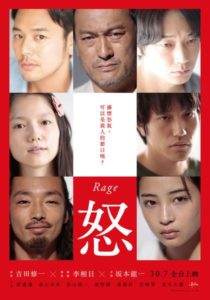Director: Sang-il Lee
Cast: Gou Ayano, Satoshi Tsumabuki, Mitsuki Takahata, Hideko Hara, Ken Watanabe, Kenichi Matsuyama, Aoi Miyazaki, Chizuru Ikewaki, Mirai Moriyama, Suzu Hirose
Running Time: 142 min.
By Martin Sandison
As I settled down to watch Rage, my second last film of this year’s Edinburgh International Film Festival, I had no idea what to expect. Director Sang Il Lee’s previous films I had heard of, but had yet to catch. The film I saw was perhaps all the better for it, as I had no frame of reference for the masterful narrative that unfolded before my eyes. Now I can’t wait to see his other films, especially the remake of Unforgiven, as the original is one of my favourite Westerns. Lee attended the festival, and despite my best efforts I couldn’t secure an interview with him. I did, however, have a chat to him at a party and we discussed our favourite Japanese and Korean directors. My introduction was: “I loved your movie”. Now let me tell you why…
A serial killer is on the loose, having perpetrated a double murder. Three seemingly unrelated storylines revolve around this central narrative. In Chiba, Maki (Watanabe, The Last Samurai) is down on his luck, but has helped his daughter Aoki (Aoi Miyazaki, Eureka) get away from a life as a sex worker. She falls for a local man Tashiro (Kenichi Matsuyama, Death Note), but suspects him as being the killer because he is going under a fake name. In Tokyo, in-the-closet businessman Yuma (Satoshi Tsumabuki, The World of Kanako) meets Naoto (Go Ayano, Lupin the 3rd), and the two have a close relationship. But Yuma suspects Naoto as being the killer as he has three moles on his cheek, as the killer does. In Okinawa, Izumi (Suzu Hirose, Chihayafaru) and her sensitive boyfriend-to-be Tatsuya (Takara Sakimoto) stumble upon drifter Tanaka (Mirai Moriyama, Fish Story), and the three become close.
The last paragraph is possibly the longest I have ever written for a plot description, and let me tell you, this film warrants it. So complex, yet so involving, the narrative had me enraptured from start to finish. Although the strands don’t intersect until the end, there is no sense that they really need to, as the themes of the film are so prevalent. These involve the nature of trust in the modern world (none of the characters trust their new friends or partners) and what leads a human to kill. While keeping the viewer guessing as to who is the serial killer, each story is in and of itself very interesting.
Director Lee is himself Zainichi Korean-Japanese, and he has lived and worked in Japan his whole life. This gives him a unique slant on life in Japan, one which is different from his contemporaries such as Kiyoshi Kurosawa (whose film Creepy contains some similarities to Rage). In fact, Lee’s first film Chong was about third generation Koreans living in Japan. He obviously has vested interest in his roots and what it means to be Zainichi, and this creates a very immersive cinematic world. Influences ranging from classic Japanese cinema such as Masaki Kobayashi to the Korean new wave are evident, but Lee rises above them with an original voice.
The acting across the board is nothing less than absolutely fantastic. Watanabe is cast against type as a man with a lot of failings, but who is a very kind hearted soul. Of course, he nails it and proves again he is one of the best actors in world cinema. Tsumabuki is superb as Yuma, a man with swaggering confidence whose laissez faire attitude can get him in trouble. His relationship with Tashiro is wonderfully drawn, with a vast depth of emotion. Izumi suffers the most in the film, and Hirose captures this loss of innocence brilliantly.
Style-wise Rage is strong but not flashy; this serves the themes and storylines of the film and never detracts from them. There are some stand out shots that deserve to be seen on the big screen, but this movie is not about visuals. At times it is a little basically shot, but this actually enhances the performances of the actors.
Both my friend and I commented afterwards that the rape scene in the middle of the film is too long and drawn out, and perhaps didn’t need to be there at all. However, director Lee said in the Q & A afterwards that he wanted to comment on the incidents of rape by American GI’s in Okinawa, which has become a big issue in recent times. After hearing this and considering the rest of the film, I believe it is necessary to appreciate the point the film is making.
Overall, Rage is one of the best films I’ve seen in the last year, and I would urge anyone who is into the drama genre to catch it. There are moments of abuse and violence, but these are few and far between when becoming glued to the screen with the film’s great narratives. A special mention goes to the soundtrack by the legendary Ryuichi Sakamoto (Merry Christmas Mr. Lawrence), that builds to a masterful crescendo come the emotionally fraught ending of the film. Highly recommended.
Martin Sandison’s Rating: 9/10



